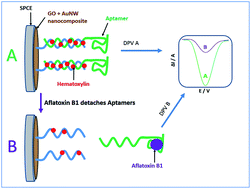Electrochemical detection of aflatoxin B1: an aptasensor prepared using graphene oxide and gold nanowires
Abstract
An electrochemical aptasensor was developed for the detection of aflatoxin B1 using a nanocomposite of graphene oxide and gold nanowires. The aptasensor mechanism was based on the difference in the differential pulse voltammetry peak current upon detachment of the aptamer from the electrode surface when the toxin is present. The working electrode modifications were confirmed using field emission scanning electron microscopy, energy-dispersive X-ray spectroscopy, and electrochemical methods cyclic voltammetry and electrochemical impedance spectroscopy. The limit of detection was 1.4 pM and the linear range was 5.0–750.0 pM with good reproducibility of the results. The specificity test of the aptasensor successfully confirmed that the aptasensor is specific towards aflatoxin B1 compared to a blank solution and non-specific molecules. A simulated real sample environment tested in pistachio samples alongside experiments and comparison with the HPLC method confirmed the aptasensor's capability to work in future real food assays.



 Please wait while we load your content...
Please wait while we load your content...